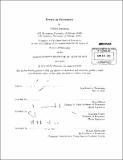Essays in economics
Author(s)
Swanson, Ashley (Ashley Terese)
DownloadFull printable version (14.09Mb)
Other Contributors
Massachusetts Institute of Technology. Dept. of Economics.
Advisor
Glenn Ellison and Jonathan Gruber.
Terms of use
Metadata
Show full item recordAbstract
The first chapter analyzes incentives and quality in hospitals with physician-investors. Proponents of physician ownership argue that it improves care; opponents claim that physician-investors "cherry-pick" profitable patients. This paper uses new data on physician-owned hospitals to estimate a model that allows for both cherry-picking and quality effects. The data contain information on the distribution of physician ownership across hospitals and I develop a probabilistic discrete choice framework to examine the selection behavior of physician-investors. A structural approach with instrumental variables provides estimates of hospital quality both on average and varying with patient characteristics. I estimate the model using a sample of non-emergency cardiac patients obtained from the Center for Medicare and Medicaid Services. I find evidence of a significant mortality improvement for patients treated at physician-owned hospitals, which primarily holds for moderate-severity patients. There is no strong evidence of physician-owner cherry-picking of healthier patients. The distribution of patients across hospitals is primarily driven by physicians' average preferences over hospitals. The second chapter explores price transparency in health care. Many U.S. states have recently begun requiring that hospitals publish prices, citing the need for consumer search. This paper uses two sources of longitudinal hospital data to evaluate the effects of Web-based price-posting requirements and on-site price-posting requirements on the distribution of hospital prices in nineteen states with such regulations. I find that transparency regulation is associated on average with small price increases, which is inconsistent with transparency enhancing consumer search. The effects are smaller among for-profit hospitals and in areas with a greater self-pay patient population. The third chapter (co-authored with Glenn Ellison) examines differences in the frequency with which students from different schools reach high levels of math achievement. Data from the American Mathematics Competitions is used to produce counts of high-scoring students from public U.S. high schools. High-achieving students are far from evenly distributed. There are strong demographic predictors of high achievement, but there are large differences among seemingly similar schools. The unobserved heterogeneity across schools includes a thick tail of schools that produce many more high-achieving students than the average school. Gender-related differences and other breakdowns are discussed.
Description
Thesis (Ph. D.)--Massachusetts Institute of Technology, Dept. of Economics, 2012. Cataloged from PDF version of thesis. Includes bibliographical references (p. 147-159).
Date issued
2012Department
Massachusetts Institute of Technology. Department of EconomicsPublisher
Massachusetts Institute of Technology
Keywords
Economics.